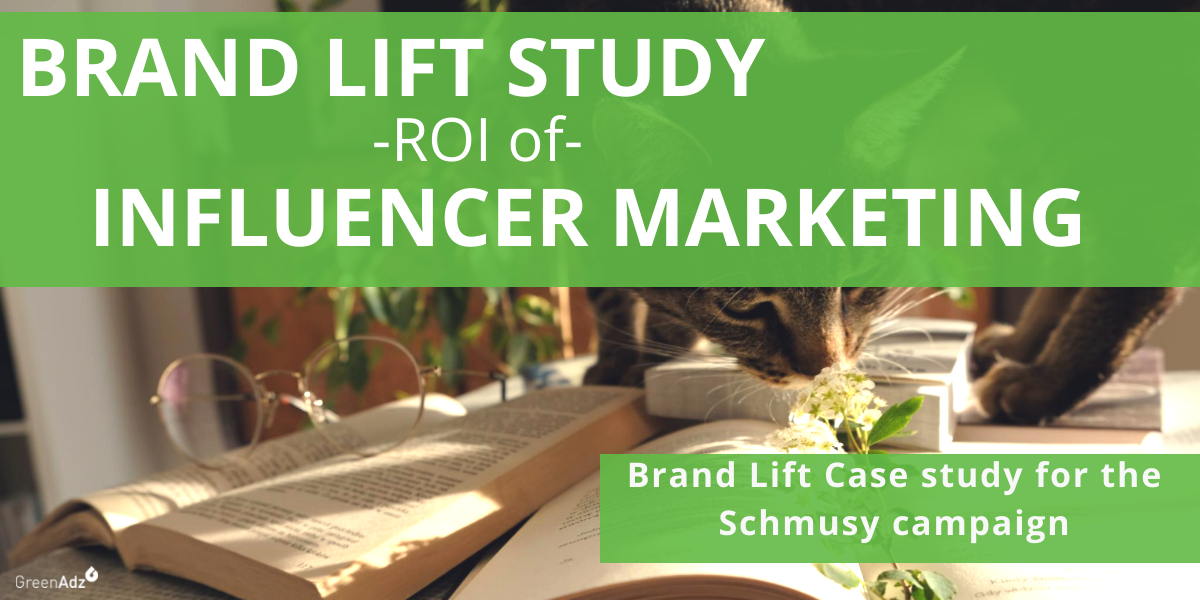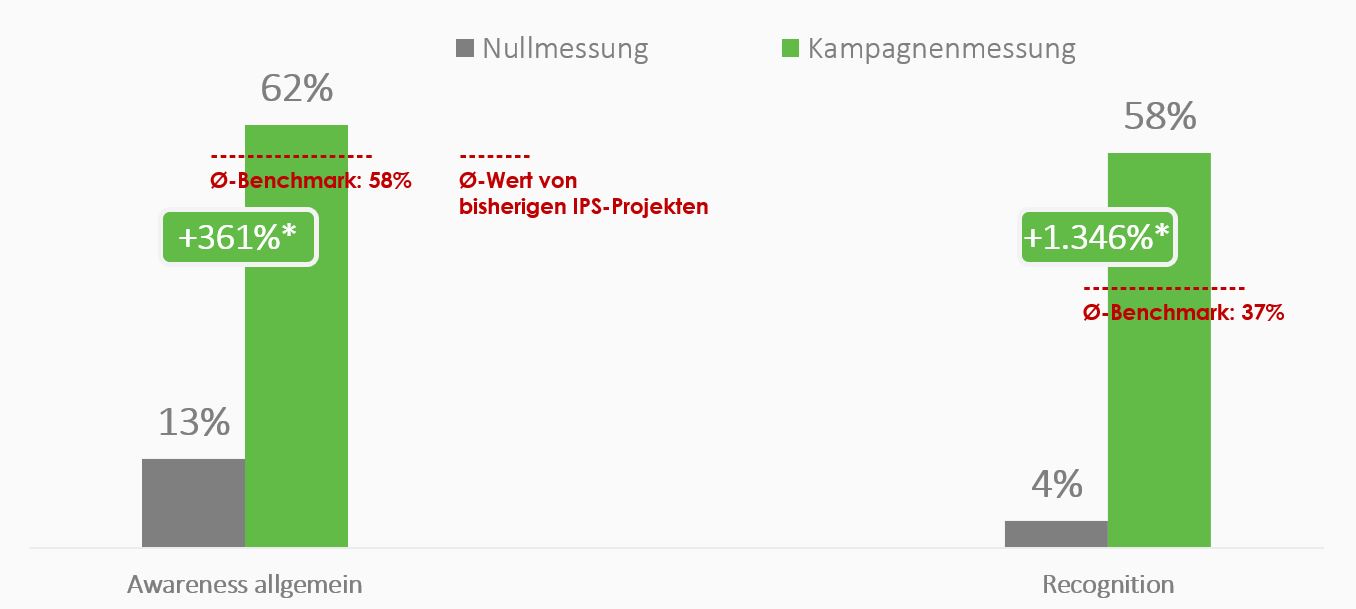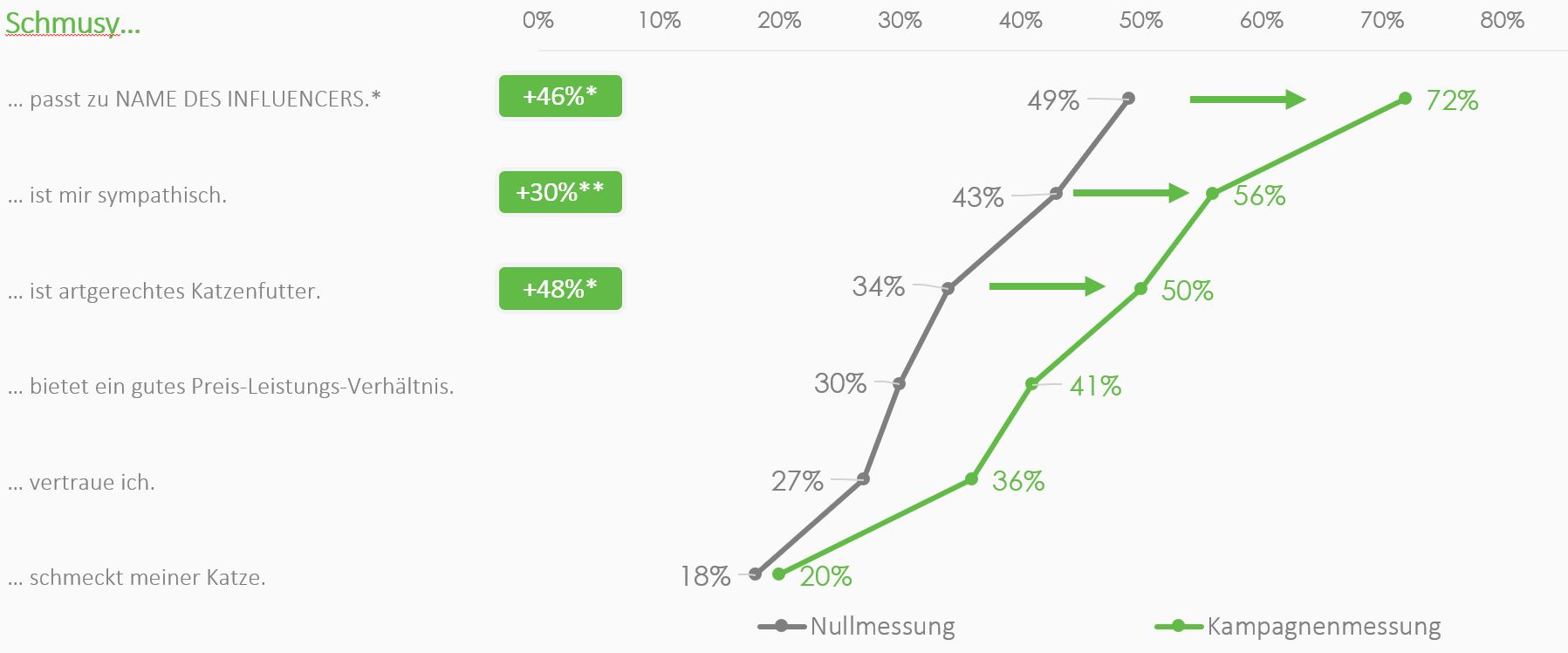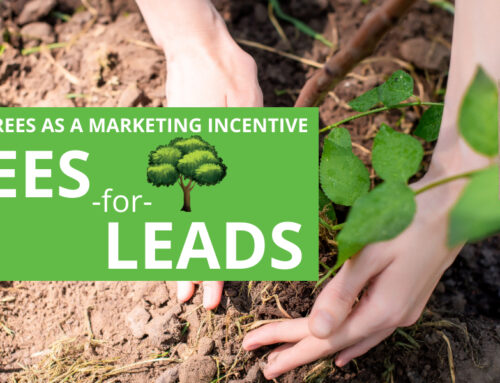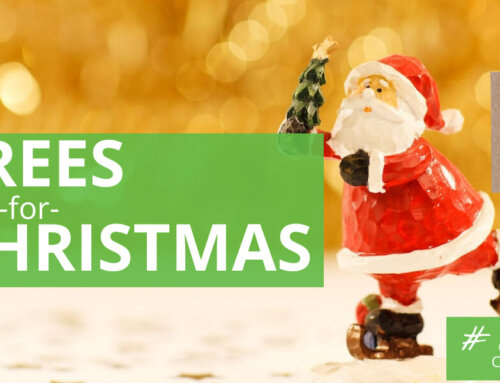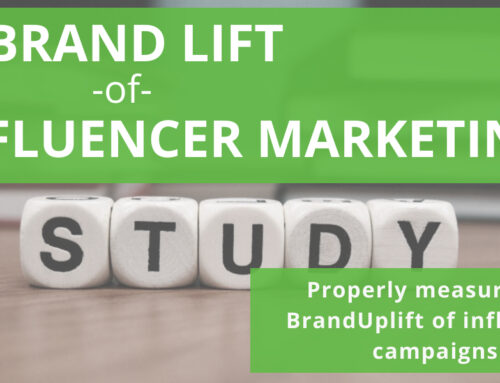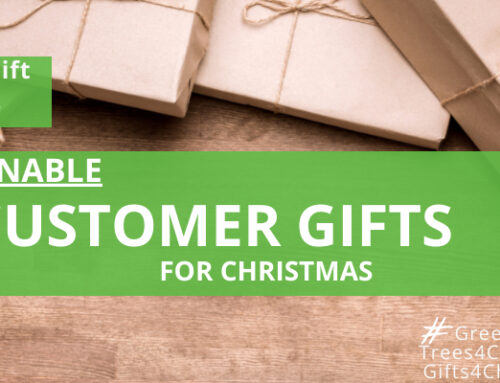ROI of Influencer Marketing: Influencer Brand Lift Study shows the advertising impact of FMCG brand
The proof of Influencer Marketing ROI was, is and remains the decisive factor in influencer marketing in order to further increase the market share of this discipline of 1.5 percent of the global advertising market.
“ROI of influencer marketing remains the Holy Grail.”
says Debbie Morrison, Managing Director Global Partnerships & Events about Ebiquity’s report on the status quo of global influencer marketing, “The rise and rise of Influencer Marketing.” “The rise and rise of Influencer Marketing”. In Linqia’s annual report „The State of Influencer Marketing“, determining ROI has also been the number one challenge in influencer marketing for years.
An important building block for proving success is campaign-accompanying advertising impact studies, as they have also been used for years in classic media genres such as TV, print, and online advertising and have contributed decisively to their growth.
For the emerging discipline of influencer marketing, GreenAdz is one of the pioneers in the industry and already in 2018 developed the “Influencer Performance Score” – IPS for short – an approach to prove the advertising impact of campaigns comparable to established methods; this was also the case for the influencer campaign of the pet food manufacturer Finnern for the Schmusy brand. The campaign was implemented by the digital agency construktiv. The sustainable research approach of the market research company GreenAdz accompanied the campaign to prove the advertising impact.
The campaign objectives were once again to increase awareness and commitment: via a photo competition in search of the cuddliest cat
From June to September 2021, a big cat photo contest took place on the “Schmusy” Landingpage with some prizes to be won.
The goal was to find the Schmusy lookalike of the year and the cuddliest cats in Germany.
Together with 14 influencers, their cats and lots of creative contributions, they drew attention to this photo competition and encouraged the communities to take part.
The Schmusy influencer team was very diverse, but had at least one thing in common: an interactive community that loves cats as much as they do – the best prerequisite for a cat photo competition.
Campaign and market research implementation: 3 out of 14 influencers invite survey and plant nearly 700 trees as an incentive for GenZ
Success factor 1: The influencer team
construktiv selected a suitable, diverse team of influencers for the campaign: From petfluencers & creative nano-influencers to classic influencers with reach and their own cats – together they were able to achieve over 470,000 organic impressions!
In the content creation, the main focus was on a wide variety of content formats and channels. For example, there was an IG reel with tips for photographing the fur noses, many cuddly pictures, informative blog posts and a funny TikTok video – and always to discover the Schmusy cat food!
Success factor 2: A survey at eye level
In order to measure success not only in terms of the usual engagement rates and impressions, but also to obtain information on the target group and changes in classic branding KPIs such as brand awareness, ad awareness and image, campaign-related market research in the form of IPS was used.
This is a before-and-after survey on the campaign – so called Brand Lift Study -, which is played out by the influencers to their community. In addition to socio-demographics, the survey covered topic-specific target group characteristics, brand awareness, advertising recall, likeability, liking of the campaign, brand image, and purchase probability or activation in the relevant target groups. The highlight: Influencers always reward participation in the survey via GreenAdz for each completed questionnaire with a tree donation as a thank-you gift – a decisive reason for many influencers to ask their community to participate in a survey in the first place.
Such brand-uplift studies have been implemented for display campaigns for about 20 years as a pop-up invitation à la “Your opinion is important to us!” incl. cookie tracking. In contrast to the pop-up variant, the innovative approach via influencer Insta-stories is not only more likeable, efficient, effective and sustainable than an approach via paid media, but also very responsive and also pays off positively for the image of the sender.
The results: Above-average engagement leads to awareness increase of over 150 percent
Agency reporting: In addition to many content pieces, over 800,000 gross contacts and above-average engagement rates
- The Schmusy campaign reached a total of 839,068 gross contacts with 14 influencers.
- Many creative content pieces were created, including 13 IG posts, 5 IG reels, many IG stories with a total of almost 80 individual slides, a TikTok video, a blog post and a Facebook post – in total, the posts generated over 26,500 likes & comments.
- A very good average engagement rate of 19.11% was achieved for the IG posts. (An engagement rate of 2-3% is already a good rate!)
- Over 1,400 link clicks on the landing page were recorded by the influencers.
- The photo competition was very well received by both the influencers and their communities: A total of at least 200 submissions can be traced back via the influencers!
A new dimension of success measurement of influencer marketing and its communication is possible through market research
The target group:
As is typical for Instagram, the campaign primarily reached women. The age distribution ranges from 20 years across all age groups up to the early 40s. Incidentally, a look at the influencer level shows the socio-demographic differences between the followers reached by the influencers used in the campaign.
High target group fit: More than two thirds of the followers surveyed have a cat, while the proportion of cat owners in the overall population is only 14% (benchmark from the biggest German media study Best for Planning)
The demonstrably great target group fit resp. audience fit – are excellent prerequisites for the campaign’s effectiveness.
Brand & Ad Awareness:
The campaign significantly increased awareness of the Schmusy brand by 163%, almost tripling it – the brand outperformed three competitors in the ranking.
The campaign achieved above-average recall values: around six out of ten of the followers surveyed remembered the photo campaign.
Image lift and activation:
Schmusy’s brand profile also tended to improve significantly for half of the items: First and foremost, the brand fit (=”The brand fits influencer xy.”) of the influencers is above average with a Top2 value of 72 percent (this could be a secret of the campaign’s success – keyword influencer selection). However, the likeability score and the information that the cat food is particularly species-appropriate were also significantly improved.
And since the goal of all marketing efforts is ultimately always to positively influence the specific purchase decision, last but not least the results of the activation KPI: The Top2 activation score – those who would be very or somewhat likely to try Schmusy for their cat – increases from 35 percent to 49 percent after the campaign – a significant increase of 42 percent. And with the high proportion of cat owners reached, this is certainly even more noticeable for the ROI.
Qualitative insights
Market research also makes it possible to obtain qualitative feedback on the campaign. This is particularly interesting for campaigns that can only draw a few substantial comments. The campaign met with a very positive response from followers: 55% of respondents (very) liked such a campaign – a third were indifferent. Among those who can specifically remember the campaign, the Top2 value is 64%, which is well above the benchmark for classic display campaigns.
In addition to the high level of acceptance of the campaign among followers, the additional open question allowed further qualitative insights to be generated into what exactly was so well received about the campaign: With real user feedback and the quotes, the positive aspects of the campaign on the part of the target group can be communicated much better than via the less emotional bar and column charts.
What exactly about the Schmusy campaign pleased…
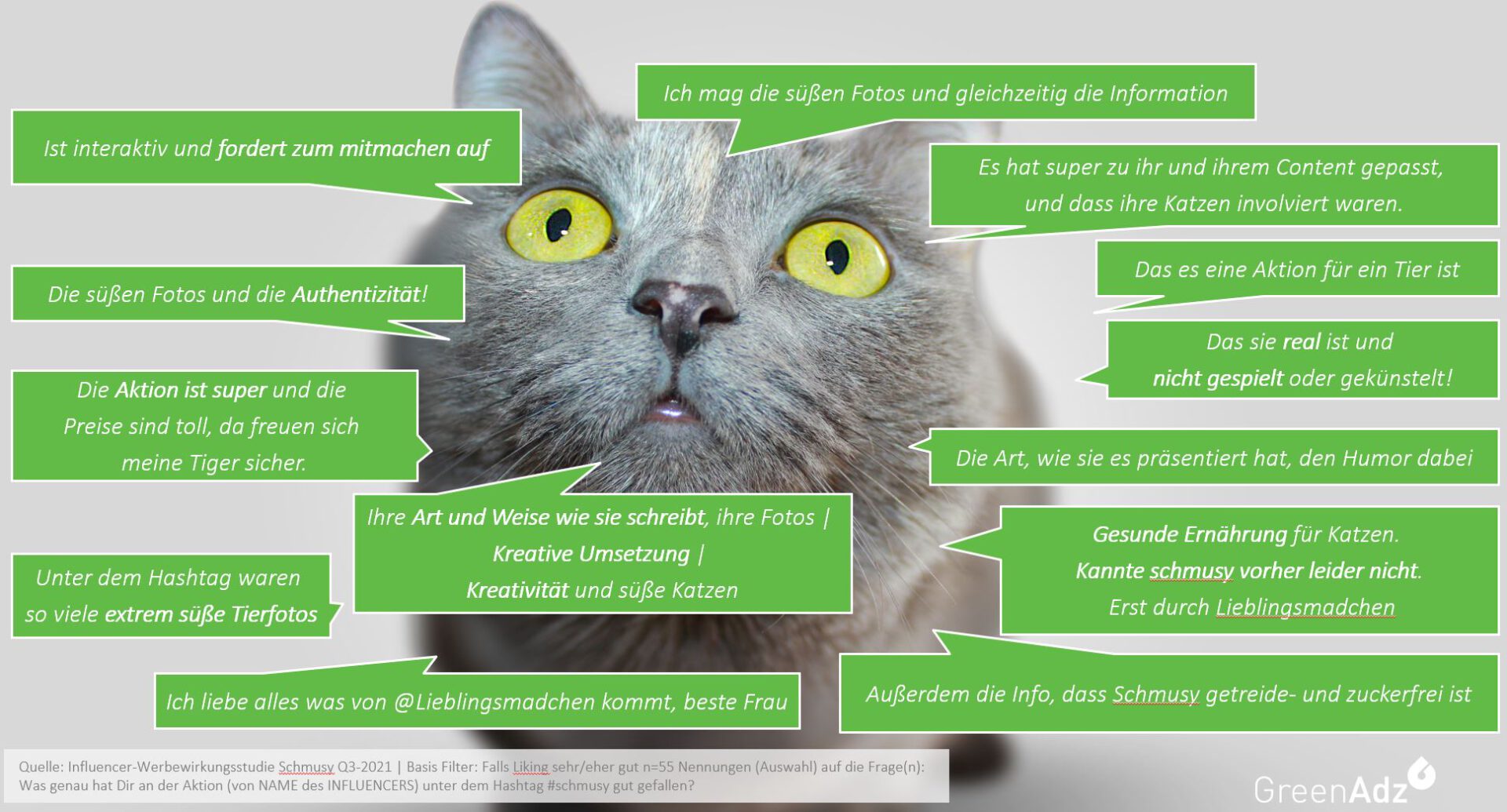
PS: For all those who love “Cat Content” as well 😉😻: For the “Schmusy-Lookalike-Competition” the winners for a total of 23 prizes have been determined in the meantime. Several hundred owners of cuddly tigers from all over Germany applied online with photos via the website. All 23 prize winners and photos at https://www.schmusy.com/aktionen/fotowettbewerb
Conclusion: Influencer marketing works – not just for “cat content”
As we were able to show in 2019, influencer marketing not only works for entertainment-related topics, but also for financial products that require explanation, such as the “Kwitt” payment app: in this Case des Bundesverbandes der Deutschen Volksbanken und Raiffeisenbanken (BVR) our market research accompanying the campaign impressively demonstrated the contribution influencer marketing can make to increasing awareness and acceptance of the payment app. Compared to the previous quarter, both new Kwitt registrations and payments with Kwitt increased significantly during the campaign period. Image improvements are also more clearly visible through the influencer campaigns than with pure online display campaigns, as our previous influencer advertising impact projects have impressively demonstrated.
„Influencer campaigns are significantly more effective on average than classic display campaigns, regardless of industry and target group“,
This is my conclusion after many hundreds of display advertising campaigns and now also many influencer campaigns that we have been able to accompany with GreenAdz.
Influencer campaigns work better than traditional online advertising due to significantly higher liking KPI
The high acceptance and popularity ratings of the campaigns in particular contribute to the clear improvement in the image of brands through influencer marketing. The so-called “liking value”, i.e. the liking of the campaign, is on average 66 percent in our previous projects, i.e. two out of three followers like the campaign (very) much – in comparison, the top 2 benchmark for classic display campaigns is only 42 percent.
The open responses on liking the campaign also show what the target group was convinced of, but also reveal potential for optimization and the critical voices on the advertising are “heard”. All this contributes to the fact that influencer campaigns demonstrably improve awareness and brand values.
Nielsen and Google also rely on influencer ROI proof through brand lift studies
While there is a body of research on the drivers of brand lift for traditional media such as television, there has been no research into the factors that significantly influence the brand lift of influencer marketing campaigns. At the beginning of 2023, the market research institute Nielsen showed what the main drivers for the branding success of influencer marketing campaigns are in its report “The secrets of success: The emerging media brand lift research” based on more than 1,000 brand lift studies of podcasts, social media (influencer marketing) and branded content.
And also Google has (finally) determined the value of influencer marketing by securing regular brand lift results they quantified the Influencer Marketing ROI of creator partnerships and compare results across marketing channels. In the article “Inside Google Marketing: How we (finally) proved the value of influencer marketing” Google impressively describes how valuable and successful influencer marketing is, especially for the communication of complex B2B products.
Download the case presentation as PDF and benchmarks of the BrandUplift KPIs
In this article, we were only able to present an excerpt of the most important information from the Schmusy case. The complete presentation including briefing, a few insights into the influencer marketing market, the campaign, the Mafo profile, the measurement of success from an agency and market research perspective as well as the most important benchmarks of our previous IPS projects and the expected uplifts of the most important advertising effectiveness metrics are available free of charge or as a thank you for registering for the Insights Letter at the following download link:
The Influencer Performance Score (IPS): Understanding the advertising impact of influencer marketing
The IPS methodology in a nutshell:
After many Mafo projects to prove the impact of influencer relations, the branding impact of influencer campaigns in particular can be effectively proven using this type of accompanying market research. This is a so-called “uplift advertising impact study” comparable to traditional media with a before measurement (zero measurement) at the beginning and one or more after measurements (campaign measurements) of the most important advertising impact KPIs via an online survey.
In this highly responsive approach, the target group reached via the influencers is first invited to take part in a survey before and after the advertising integration. This is always incentivized with a tree donation.
The result: uplifts of the most important KPIs to
- Target groups
- Branding
- Activation
as well as in-depth insights into the target group reached, qualitative insights, brand perception and various activation KPIs.
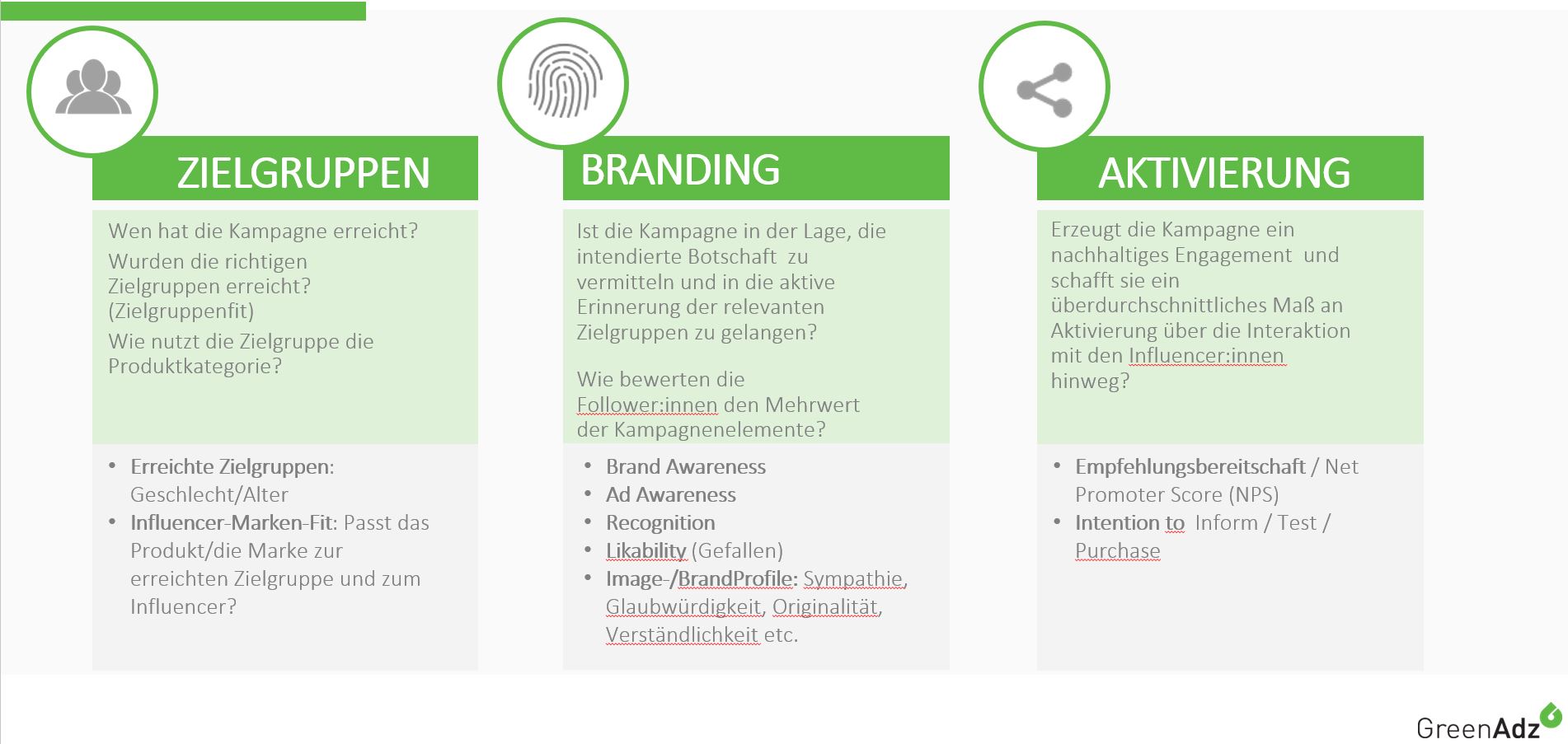
The GreenAdz Influencer Performance Score (IPS): 15-20 questions = comprehensive understanding thanks to Brand Lift study
For each influencer, the number of participants for control and campaign measurement is controlled in such a way that the study is based on a sample size per influencer and measurement of approx. 130 to 150 cases. The result is an innovative advertising effectiveness study in which the uplifts of the most important advertising effectiveness KPIs can be shown across the board and additional insights into the target group reached by the influencers can also be determined over several waves.
Are you planning an influencer marketing campaign and want to learn more about the success, impact and mechanisms of your influencer marketing activities? Get in touch – and we will briefly and clearly present our approach to proving the impact of your influencer marketing activities with campaign-accompanying market research. In our webinar, I will also explain the approach to you in a half-hour video. Click here to register for the webinar. Or call me directly if you have any questions: +49 151-22632872.
Best regards and hope to see you soon in person!
Sandra Gärtner
About the author:
Dr. Sandra Gärtner is co-founder of the market research and technology service provider GreenAdz and, with mediaresearch42, an independent market research consultant with a passion and a green soul from Hamburg. Green, because GreenAdz stands for “market research that plants trees” and is often referred to by our interviewees as “Viva con Agua for market research”. This sustainable incentive concept is particularly effective in the field of influencer marketing research – especially for campaign-accompanying advertising impact studies of influencer campaigns in the GenZ.
About the agency construktiv:
construktiv is a progressive and sustainably growing digital agency with around one hundred employees in Bremen, Berlin and Erfurt. Founded in 1997, the agency today comprises the business areas of social media & influencer marketing, digital marketing including content and creation. Its clients include many established and new brands from the B2B, construction, education, finance & insurance, food & beverage, health & pharmaceutical, infrastructure & logistics, IT and telecommunications, culture, entertainment & media, non-profit, retail, consumer goods and tourism sectors.
